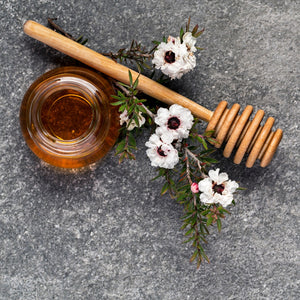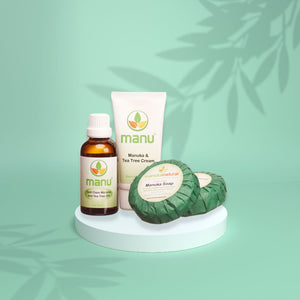10 Things you need to know BEFORE you buy Manuka honey
1. Over 80% of honey sold around the world as Manuka honey is fraudulently labelled!
According to NZ Ministry of Primary Industries statistics, New Zealand produced 1700 tonnes of Manuka honey in 2014, however statistics also show that over 10,000 tonnes of honey were sold around the world labelled as Manuka honey.
This means that at least 8300 tonnes (and probably a lot more than that) was fraudulently labelled as Manuka honey. This honey may contain little or no Manuka nectar, may have been adulterated with other low cost honey or even been supplemented with corn syrup!
2. Even pure Manuka honey is not created equal. Manuka plants grow throughout New Zealand but only some chemotypes (varieties) from certain regions contain dihydroxyacetone or DHA in the nectar which the bees convert to methylglyoxal - commonly known as MGO.
Methylglyoxal is the compound that gives Manuka honey the additional antimicrobial properties that are so effective in wound healing.
3. There are a range of confusing and sometimes deliberately misleading label names and numbers that describe Manuka honey, its purity and antimicrobial activity.
Some producers use pollen count to establish the purity of the nectar source. This can be very misleading for two reasons, 1, The pollen from Manuka flowers is almost identical to the pollen from a close plant relative Kanuka which has no additional antimicrobial properties, making this a flawed test.
Even if the pollen count is high, confirming that most of the honey is in fact sourced from Manuka flowers, it may be from a region which does not produce dihydroxyacetone or DHA, which means that this honey has no special attributes other than flavor.
4. Labels carrying terms like K Factor, NPA,TA, PA, Active, Organic, Bio-Active, AAH, etc. accompanied by numbers like 15+, 20+, 25+, even 70+ are misleading and are not an accurate measure of the additional antimicrobial properties of Manuka honey.
When Wedderspoon were recently asked what the methylglyoxal content of their "K Factor 16" honey was, their representative in New Zealand told us that they did not test for this - the most important compound relating to additional antimicrobial properties of Manuka honey and they don't test for it!
That statement would appear to mean – none at all – if their honey did contain methylglyoxal and qualified for the UMF© Trademark they would surely publish it as justification for their prices. (Wedderspoon were not a licensed member of Unique Manuka Honey Association of New Zealand at the time of writing).
The only certification you can trust is UMF©
UMF© is an independently tested, strictly enforced certification which directly proportional to the methylglyoxal content of the tested honey and its antimicrobial effectiveness.
Unless the numbers on the label are accompanied by the UMF© Trademark, and /or the methylglyoxal content it is simply an attempt to mislead the customer.
5. Only honey which has been produced, packed into pots and labelled in New Zealand by a licensed member of the Unique Manuka Honey Association of New Zealand can qualify for the UMF© Trademark and Certification.
Fraudulent use of this Trademark carries prosecution by the New Zealand Commerce Commission and fines of $100,000 have been applied by the courts for past convictions.
However the New Zealand Commerce Commission has no jurisdiction overseas where honey is sold, so in some countries anything goes!
Furthermore, at this time overseas food safety authorities do not have the sophisticated analytical equipment to identify honey fraudulently labelled as Manuka honey.
6. There is no such product as cheap certified Manuka UMF© honey.
In New Zealand, land owners, beekeepers, processors and distributors all know the value of genuine certified Manuka UMF© honey containing high levels of methylglyoxal as does the medical and cosmetic industry who are prepared to pay high premiums for it. Do not be fooled into thinking that you are getting this quality of Manuka honey at a bargain price.
7. To get an indication of the international prices of Manuka UMF© honey check www.comvita.com Comvita are the largest producer of Manuka honey in the world and their prices reflect the premium applied to high certifications of genuine Manuka UMF© honey.
8. However, smaller New Zealand based on-line stores like Manuka Natural Ltd. www.manukanatural.com also stock the same quality and UMF© certification as Comvita and are able to sell it at lower prices due to lower overheads. This is likely to be the best deal you can get for high quality certified Manuka UMF© honey.
9. If you are buying Manuka honey in your own locality, ask the vendor what the methylglyoxal or MGO content is. If they can’t or won’t tell you or they simply don’t know, then do not pay more than you would for normal floral honey.
10. For the most competitive pricing for genuine certified Manuka UMF© honey our advice is to buy on-line from a smaller New Zealand based company and if you want the honey with the highest levels of antimicrobial activity, only buy honey that displays the UMF© Trademark UMF© + rating and the Methylglyoxal content.



Leave a comment